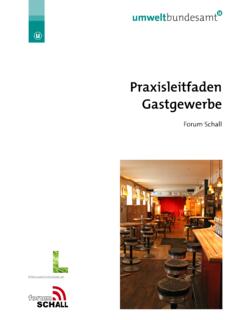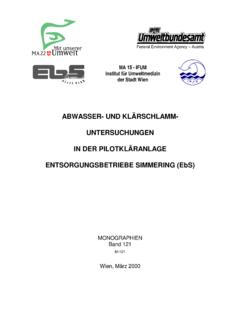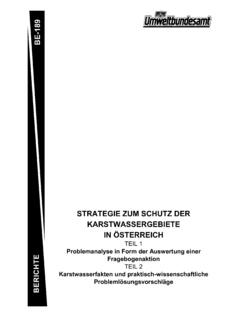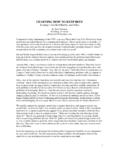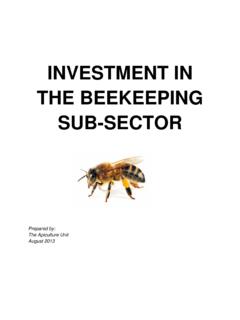Transcription of NEOBIOTA - Umweltbundesamt
1 NEOBIOTA . From Ecology to Conservation 4th European Conference on Biological Invasions Vienna (Austria), 27 - 29 September 2006. Book of Abstracts BfN-Skripten 184. 2006. NEOBIOTA . From Ecology to Conservation 4th European Conference on Biological Invasions Vienna (Austria), 27 - 29 September 2006. Book of Abstracts compiled by Wolfgang Rabitsch Frank Klingenstein Franz Essl Sponsors: Compilers: ORGANISING COMMITTEE. Dr. Wolfgang Rabitsch Umweltbundesamt , Austrian Federal Environment Agency Dr. Franz Essl Spittelauer L nde 5, 1090 Wien, Austria Frank Klingenstein German Federal Agency for Nature Conservation Konstantinstr. 110, 53179 Bonn, Germany SCIENTIFIC COMMITTEE. Dr. Franz Essl ( Umweltbundesamt , Austrian Federal Environment Agency, Vienna). Dr. Piero Genovesi (Italian National Wildlife Institute and IUCN Invasive Species Specialist Group Europe, Ozzano Emilia).
2 Prof. Dr. Georg Grabherr (Department of Conservation Biology, Vegetation and Landscape Ecology, University of Vienna). Frank Klingenstein (German Federal Agency for Nature Conservation, Bonn). Dr. Stefan Klotz (UFZ Centre for Environmental Research, Halle). Prof. Dr. Ingo Kowarik (Institute for Ecology, TU Berlin). Prof. Dr. Otto Moog (Institute of Hydrobiology and Aquatic Ecosystem Management, Univer- sity of Natural Resources and Applied Life Sciences, Vienna). Prof. Dr. Wolfgang Nentwig (Zoological Institute, University of Bern). Dr. Vadim Panov (Zoological Institute, Russian Academy of Sciences, St. Petersburg). Prof. Dr. Petr Pysek (Institute of Botany, Czech Academy of Sciences, Pruhonice). Dr. Wolfgang Rabitsch ( Umweltbundesamt , Austrian Federal Environment Agency, Vienna). Prof. Dr. Tod Stuessy (Department of Systematic and Evolutionary Botany, University of Vienna).
3 This publication is included in the literature database DNL-online ( ). BfN-Skripten are not available in book trade. Publisher: Bundesamt f r Naturschutz (BfN). Federal Agency for Nature Conservation Konstantinstrasse 110. 53179 Bonn, Germany URL: All rights reserved by BfN. The publisher takes no guarantee for correctness, details and completeness of statements and views in this report as well as no guarantee for respecting private rights of third parties. Views expressed in the papers published in this issue of BfN-Skripten are those of the authors and do not necessarily represent those of the publisher. No part of the material protected by this copyright notice may be reproduced or utilised in any form or by any means, electronic or mechanical, including photocopying, recording or by any information stor- age and retrieval system without written permission from the copyright owner.
4 Printed by the printing office of the Federal Ministry of Environment, Nature Conservation and Nuclear Safety. Printed on 100% recycled paper. Bonn, Germany 2006. Preface Biological invasions by alien species ( NEOBIOTA ) are of growing concern in recent years. This is not only reflected by the increase of scientific research efforts, but also by national and international pol- icy and legislation. Thus on a worldwide scale, invasive alien species (IAS) are considered to be one of the major driving forces of biodiversity loss and global change. In Europe, a long research tradition on the impact of man on habitats and species exists, often strongly associated with changes in species distributions. Although the history of species introduc- tions in Europe often is ancient, the nowadays increasing possibilities for IAS in new environments challenge conservation efforts to protect biodiversity.
5 IAS are models for successful Pan-European partnership and sense of responsibility beyond national borders. One step in this direction are meet- ings to share and discuss informations, opinions and new thoughts. Since the first meeting in the year 2000 in Berlin and the following conferences in Halle and Bern, this 4th European NEOBIOTA conference in Vienna again reflects all fields of biological invasions includ- ing all types of organisms (pathogens, plants, fungi, animals) and habitats (marine, freshwater, and terrestrial ecosystems) and it brings together representatives from all groups interested in the world of biological invasions (ecologists, conservationists, and stake-holders). This meeting will pay special attention to questions on implementation of IAS-issues, based on sound scientific knowledge from the ecology of species to the conservation of Europe s biodiversity.
6 The organising institutions of this meeting, the Austrian Federal Environment Agency and the German Federal Agency for Nature Conservation, welcome you to Vienna and wish you an exciting and inter- esting conference. The organising committee: Wolfgang Rabitsch, Frank Klingenstein, Franz Essl Austrian Federal Environment Agency & German Federal Agency for Nature Conservation 3. NEOBIOTA . From Ecology to Conservation 4th European Conference on Biological Invasions University Campus; Vienna (Austria). 27 - 29 September 2006. Programme Wednesday, 15:00- Registration 20:00. 17:15 W Rabitsch Welcome Invited keynote lecture: We CAN stop the in- 17:20 D Simberloff vasion juggernaut! High tech and low tech success stories Thursday, 08:00- Registration 18:00. 08:30 W Rabitsch Welcome 08:35 K Kienzl Welcome 08:40 R Blanke Welcome 08:45 G Obermayr Opening I Implementation and Conservation Chair F Klingenstein 08:50- J McNeely Invited keynote lecture: Biodiversity Conserva- 09:30 tion and Invasive Alien Species: What will it take to deal with biological globalization?
7 1 Policy and Legislation 09:30- CA Miller, MK Kettu- Analysis of the European legal and policy 09:50 nen & C Shine framework on Invasive Alien Species 09:50- S Brunel Presentation of EPPO tools and activities 10:10. 10:10- F Klingenstein Resolution 10:20. 10:20- Coffee Break Poster 1-40. 10:50. 4. 2 IAS in Europe Chair F Essl 10:50- P Hulme Biological Invasions: Is the European Union 11:30 response sufficient? 11:30- A Traveset et al. Performance of invasive species across medi- 11:50 terranean islands 11:50- IR Weidema An overview of alien and invasive species in 12:10 North and Central Europe based on data from the North European and Baltic Network on In- vasive Alien Species (NOBANIS). 12:10- T Shiganova Pattern of invasion, establishment and distri- 12:30 bution of alien species in the Ponto-Caspian 12:30- Lunch 13:30.
8 Chair I Kowarik 13:30- Z Botta-Duk t Plant invasion as threat of Hungarian habitats: 13:50 data from survey of whole country 13:50- MO Hill et al. Non-native species in England 14:10. 3 Pathways and Vectors 14:10- D Minchin et al. Pathways of aquatic species invasions in 14:30 Europe 14:30- M von der Lippe & Plant invasions along road corridors - the role 14:50 I Kowarik of long-distance dispersal by vehicles 14:50- K Dehnen-Schmutz A century of the ornamental plant trade in Brit- 15:10 et al. ain and its impact on plant invasion success 15:10- HJ MacIsaac et al. Use and limitations of molecular markers in 15:30 identification of invasion pathways 15:30- Coffee Break Poster 41-80. 16:00. 4 Risk Assessment Chair P Genovesi 16:00- RHA Baker et al. Developing a Risk Assessment Scheme for all 16:20 UK Non-native Species 16:20- JH Wanink Limited scope for impact and risk assessment 16:40 of invasive alien species in complex ecosys- tems: a case study from Lake Victoria 5.
9 5 Mitigation and Control 16:40- P Clergeau & P Y - A nice but predating bird species new to West- 17:00 sou ern Europe: the difficulties of management deci- sion on the sacred ibis 17:00- H Roy Natural enemies of the invasive ladybird, 17:20 Harmonia axyridis: potential for control? 17:20- G Inglis et al. Leaky border or unseen species? The utility 17:40 (and futility) of generalized pest surveys for monitoring incursions by non-native species 17:40- Seier et al. Wanted Dead - Target Weeds for Biological 18:00 Control in Europe 18:00- Coffee Break Poster 81-120. 18:15. 18:15- I Kowarik NEOBIOTA meeting 18:45. 19:30 Gathering 20:00 Conference Dinner Friday, 08:00- Registration 18:00. II Ecology of IAS. 6 Impact on Animal and Plant Health 08:30- B Sures Invited keynote lecture: Neozoic parasites in 09:10 Europe 09:10- H H rweg & H Satt- Intruder alert: Fasciola hepatica and Fascio- 09:30 mann loides magna 09:30- G Kastberger The African Small Hive Beetle.
10 A global threat 09:50 to the European Honeybee 09:50- H Reisenzein Renewed outbreak of grape phylloxera Viteus 10:10 vitifoliae in Austrian viticulture 10:10- M Vil & N Barto- Impact of plant invaders on plant-pollinator in- 10:30 meus teractions 10:30- Coffee break Poster 121-160. 11:00. 11:00- Conference Photo 11:10. 6. 7 Traits and Genetics of IAS. Chair I K hn 11:10- P Pysek et al. Traits associated with invasiveness in alien 11:30 plants: where do we stand? 11:30- M Kenis et al. Species traits facilitating the introduction and 11:50 establishment of invasive insects 11:50- E K ster et al. Which traits comprise a successful invader? 12:10. 12:10- C Krebs et al. Genetic diversity of invasive Fallopia-species 12:30 and their hybrids in Central Europe 8 Distribution and Abundance 12:30- K Wittmann Distribution and invasive potential of the 12:50 Ponto-Caspian Mysidae (Crustacea: Mala- costraca: Peracarida: Mysida).

